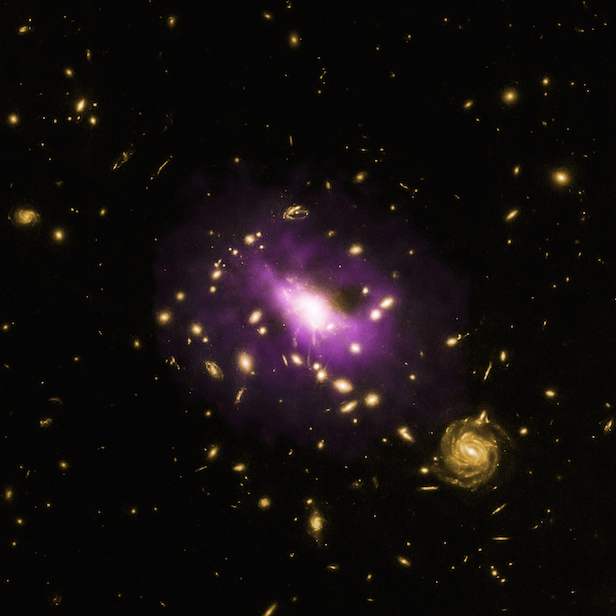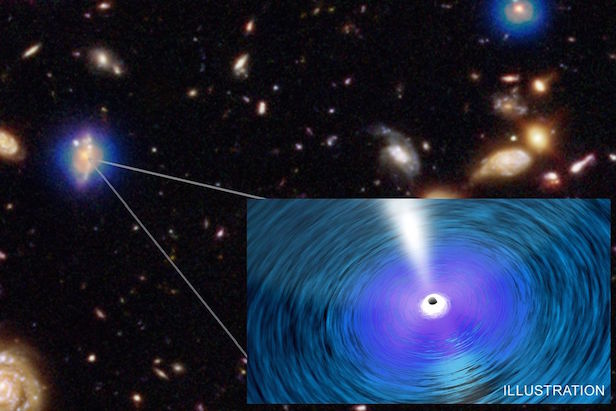“Ultramassive” black holes are eating their host galaxies
A team of international astronomers has found a selection of black holes, even larger than supermassive black holes, up to 3.5 billion light years away

Ultramassive black holes devour and destroy the matter surrounding it. Image credit: NASA/CXC/Standford/J.Hlavacek-Larrondo et al/NASA/ESA/STScI/M.Postman/CLASH
NASA’s Chandra X-ray telescope helped find a group of “ultramassive” black holes destroying their host galaxies. These galaxies are as far away as 3.5 billion light years from Earth, and the results reveal that the ultramassive black holes are growing faster than the stars in their respective galaxies.
This discovery was made by an international team of astronomers, led by Julie Hlavacek-Larrondo, a professor in the Department of Physics at Université de Montréal, and Mar Mezcua, a postdoctoral fellow at the Institute of Space Sciences in Spain. This team studied 72 galaxies that are located in the centre of the universe’s most massive and brightest galaxy clusters.
“A black hole is an invisible celestial object whose gravitational pull is so strong that neither matter nor light can escape it – it swallows everything in its path like a bottomless vortex,” explains Hlavacek-Larrondo. “A black hole is most often created when a massive star dies and collapses on itself. The most fascinating thing about black holes is how they distort time around them. According to Einstein’s theory of relativity, time flows more slowly in strong gravitational fields, like those of these gargantuan celestial objects.”
By using NASA’s pristine Chandra X-ray telescope, the astronomers calculated the masses of black holes in several galaxy clusters, based on its X-ray and radio wave emission. The analysis concluded that the masses for these ultramassive black holes are roughly 10 times greater than those originally projected. The initial projection is based upon a method that assumes black holes grow simultaneously with their galaxies. In addition to this, the results showed that almost half of the sample’s black holes are thought to be at least 10 times more massive than our Sun. Because of this, these stars are placed in a category that is beyond the usual “supermassive” black hole, as it doesn’t suffice. Some astronomers now refer to this category as “ultramassive” black holes.
“We have discovered black holes that are far larger and way more massive than anticipated,” says Mezcua. “Are they so big because they had a head start or because certain ideal conditions allowed them to grow more rapidly over billions of years? For the moment, there is no way for us to know.”

These ultramassive black holes are at least 10 billion times more massive than our Sun. Image credit: NASA
“We do know that black holes are extraordinary phenomena,” Hlavacek-Larrondo adds. “So it’s no surprise that the most extreme specimens defy the rules that we have established up until now.”
These celestial behemoths positioned at the centre of their galaxies appear to be devouring its surroundings. The incredibly high masses of these objects mean that they have a much greater gravitation attraction on the matter that hides it away. This means material, like gas and stars, is sucked in, and then as a consequence, powerful jets are emitted which destroy much of its host galaxy.
“But there’s no need to worry about our own galaxy,” says Hlavacek-Larrondo. “Sagittarius A, the Milky Way’s supermassive black hole, is a bit boring. It’s not very active, much like a dormant volcano. It sucks up little matter and probably wouldn’t be able to produce destructive high-energy jets.”
Hlavacek-Larrondo focuses her work on black holes in distant galaxy clusters, as they are hugely influential on their galactic neighbourhood, lasting for billions of years. “They are the most powerful objects in the universe, and they are anything but quiet,” she explains. “Galaxies are the building blocks of our universe, and to understand their formation and evolution, we must first understand these black holes.”
Keep up to date with the latest reviews in All About Space – available every month for just £4.99. Alternatively you can subscribe here for a fraction of the price!




